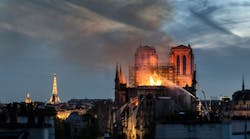Latest from Yates
Sponsored
Watching Notre Dame Cathedral in Paris, France, burn was gut wrenching. All indications are the fire was connected to the ongoing renovations. Imagine you were on the crew that had been working that day. When I saw pictures of the attic at Notre Dame (https://www.cnn.com/style/article/nortre-dame-fire-oak-wood-trnd/index.html), it struck me just how many similar tinder-dry timber-framed attics of churches, warehouses-turned-apartments, theaters and hotels I’ve been in over the past five decades to perform work. It also amazes me how many crushed-out cigarette butts are often present. Performing “hot work” in these confined spaces presents clear and present dangers that often cannot be avoided. One thing missing at Notre Dame and all those attic spaces I’ve visited: a sprinkler system! Hopefully fire suppression will get the attention it deserves during the rebuild and for other structures.
Where do we find the mechanical equipment in these darkened recesses of buildings? In their timber-framed attics, of course. The timber framed attic at a local church is hauntingly similar to what had been Notre Dame's attic construction. That's where their existing eight air handlers are shoehorned in-between the timber framing. Getting into the attic above the sanctuary is no easy feat. You have to go through the Rectory and exit to the second floor "porch", climb over a condenser that serves the rectory, up a set of wooden stairs, traverse a sloped roof, enter an access door to climb a curved ladder (2x3's fastened to framing that matches the curve of the sanctuary upper wall), then a steep ladder to reach the catwalk that runs the length of the sanctuary where the air handlers are located. That's the ordeal you have to overcome just to change the air filters! No surprise then, that when we first serviced those eight air handlers, the air filters completely blocked the sun when held up to the sun’s rays: more like blankets instead of air filters!
Getting those air handlers up there was, no doubt, an arduous task. Given the fact that you can barely squeeze by each air handler and that the timber-frame forms a constricted upside-down V, changing out any but the very first air handler will pose an incredible challenge – unless a new approach is considered. Looking around at the copper refrigerant lines, there were dozens of braze joints quite close to the tinder-dry beams. The planked cross-walk hovers over deep recessed cavities just waiting for a dropped cigarette, dripping molten braze media, a dropped red-hot fitting, an errant spark, or frayed wiring exposing wires that could arc or short. If you found yourself on the wrong end of a fire on that catwalk, your only way out would be through the plastered ceiling that’s 45’ above the pews. Geronimo!
Let’s be honest here: most mechanical contractors are not strictly following hot work guidelines. Sole proprietors don’t have a second set of eyes to be on fire-watch. Be aware that the chemicals available for flushing older R22 oil from copper line sets are very flammable. Don’t be fooled by the liquid chemical having evaporated because the vapors are extremely flammable and can result in a flash-fire the instant you light up your oxy/acetylene torch. In Notre Dame’s case, those 850-year-old oak timbers had been subjected to centuries of hot-attic drying, which made them exceptionally susceptible for combustion. The first alarm came in after the workers were gone for the day. Following the first alarm and attic check - no fire was detected. A second alarm and attic check, just 25-minutes later, revealed the fire was substantially involved.
I reached out to York City Fire Chief Chad Deardorff to ask what guidelines were suggested for hot work and he echoed the guidelines provided by OSHA.
- Identify what potential hazards are present before starting the work.
- If loose combustible materials are near the work area, sweep & clean out as needed.
- Have fire extinguisher(s) present, ensure they are the proper type, and know how to use them.
- Have someone else present to be on fire-watch and that is to be their only job.
- If possible, cover combustibles with a fire-resistant tarp.
- If a confined space, continuous air quality monitoring while following OSHA guidelines using certified personnel.
OSHA defines flammable as ignition under 100F while combustible as 100F to 200F range. What is Hot Work? Soldering; brazing; cutting (Sawzall, grinder, plasma, or torch); heat gun, pipe thawing, any open flame; or any power tool operation that can generate sparks.
Commercial work sites often have strict oversight regarding hot work. When we were contracted to install the radiant hydronic snowmelt tubing and manifolds at the York Hospital Wellspan helipad, ambulance bays, roadways, bridges, sidewalks, and emergency entrance, we wrestled with ¾” PEX tubing in 6F outdoor weather. It would have been nice to have a turbo-heater to warm the PEX, but the open flame would have required a fire watch that would have to be manned for hours after work was completed each day.
One of the first jobs I worked on as an apprentice was installing baseboard heating in a centuries old farmhouse. The stone foundation was two feet thick and that meant soldering ¾” copper in the deep recess under the floors atop that foundation. I was soldering a joint on the second floor when the other apprentice came casually up from the basement and waited patiently for me to finish soldering. Then he said: “I think I may have set the house on fire!” Rushing to the basement, smoke was billowing out from one of the deep recesses between floor joists. Fortunately, a bucket of water could quickly be drawn from the well water pump tank and tossed into that void to quickly douse the embers. More water followed and we kept a close eye on that spot for the remainder of the day.
Notre Dame Cathedral will no doubt be rebuilt, but at considerable expense and over many years. If you’re doing hot work don’t forget to follow those common sense guidelines. Believe me, there’s not enough time to run to retrieve a fire extinguisher from your truck before a fire can be beyond being extinguished, or contained, by a single fire extinguisher.
Dave Yates material both in print and online is protected by Copyright 2019. Any reuse of this material (print or electronic) must have the express written permission of Dave Yates and CONTRACTOR magazine. Please contact via email at [email protected].
Dave Yates
Dave Yates material in print and on Contractor’s Website is protected by Copyright 2017. Any reuse of this material (print or electronic) must first have the expressed written permission of Dave Yates and Contractor magazine.


